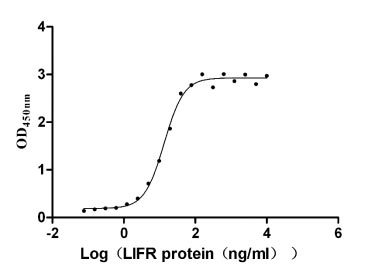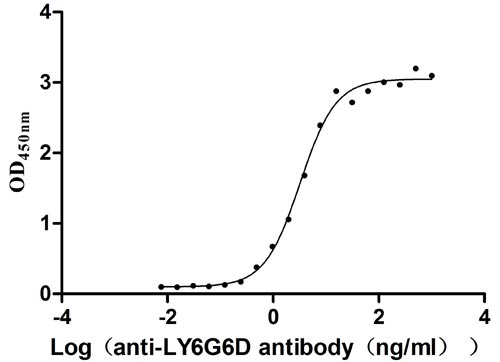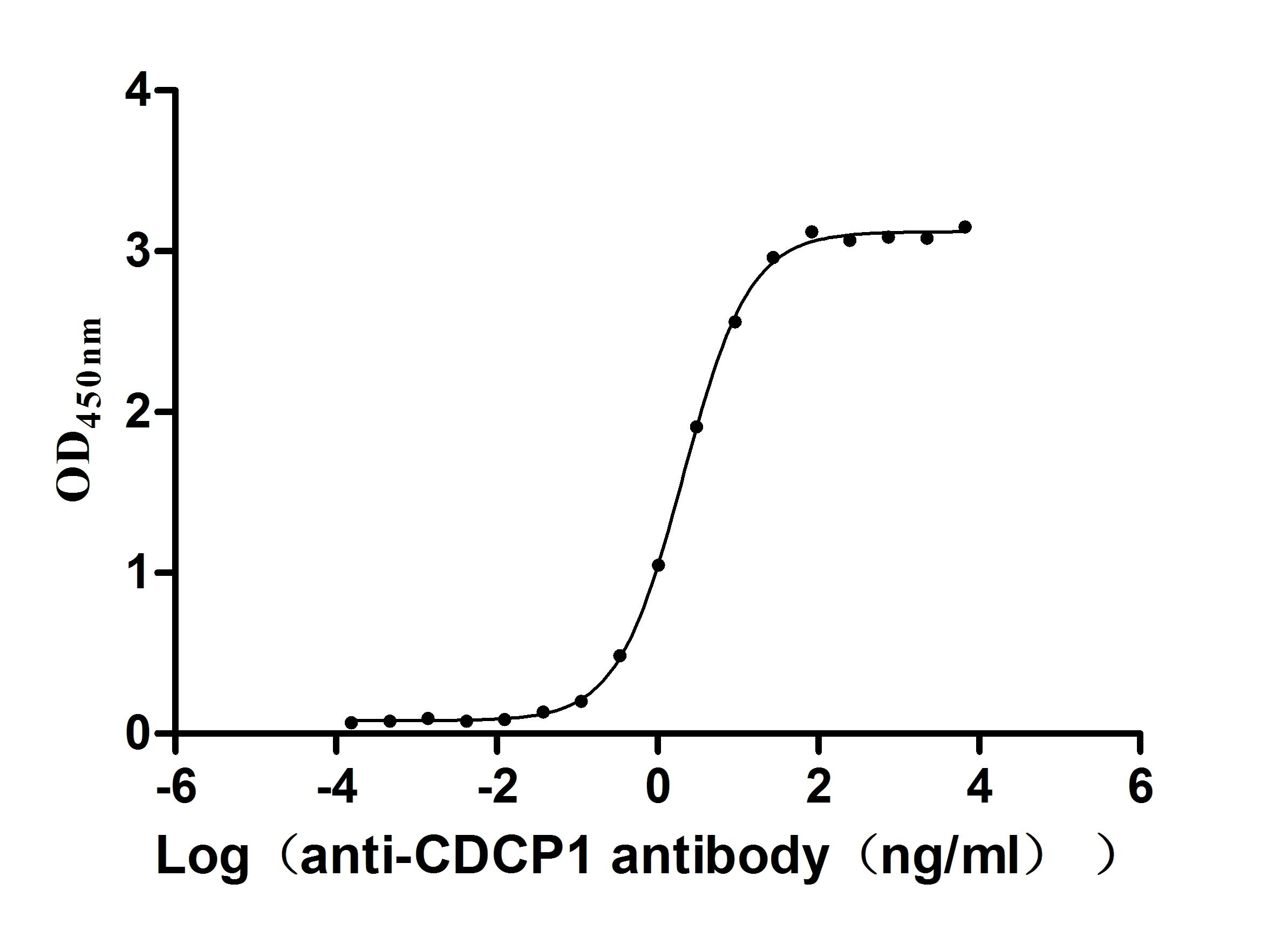Recombinant Mouse Somatotropin (Gh1)
-
货号:CSB-YP009407MO
-
规格:
-
来源:Yeast
-
其他:
-
货号:CSB-EP009407MO
-
规格:
-
来源:E.coli
-
其他:
-
货号:CSB-EP009407MO-B
-
规格:
-
来源:E.coli
-
共轭:Avi-tag Biotinylated
E. coli biotin ligase (BirA) is highly specific in covalently attaching biotin to the 15 amino acid AviTag peptide. This recombinant protein was biotinylated in vivo by AviTag-BirA technology, which method is BriA catalyzes amide linkage between the biotin and the specific lysine of the AviTag.
-
其他:
-
货号:CSB-BP009407MO
-
规格:
-
来源:Baculovirus
-
其他:
-
货号:CSB-MP009407MO
-
规格:
-
来源:Mammalian cell
-
其他:
产品详情
-
纯度:>85% (SDS-PAGE)
-
基因名:
-
Uniprot No.:
-
别名:Gh1; Gh; Somatotropin; Growth hormone
-
种属:Mus musculus (Mouse)
-
蛋白长度:Full Length of Mature Protein
-
表达区域:27-216
-
氨基酸序列FPAM PLSSLFSNAV LRAQHLHQLA ADTYKEFERA YIPEGQRYSI QNAQAAFCFS ETIPAPTGKE EAQQRTDMEL LRFSLLLIQS WLGPVQFLSR IFTNSLMFGT SDRVYEKLKD LEEGIQALMQ ELEDGSPRVG QILKQTYDKF DANMRSDDAL LKNYGLLSCF KKDLHKAETY LRVMKCRRFV ESSCAF
-
蛋白标签:Tag type will be determined during the manufacturing process.
The tag type will be determined during production process. If you have specified tag type, please tell us and we will develop the specified tag preferentially. -
产品提供形式:Lyophilized powder
Note: We will preferentially ship the format that we have in stock, however, if you have any special requirement for the format, please remark your requirement when placing the order, we will prepare according to your demand. -
复溶:We recommend that this vial be briefly centrifuged prior to opening to bring the contents to the bottom. Please reconstitute protein in deionized sterile water to a concentration of 0.1-1.0 mg/mL.We recommend to add 5-50% of glycerol (final concentration) and aliquot for long-term storage at -20℃/-80℃. Our default final concentration of glycerol is 50%. Customers could use it as reference.
-
储存条件:Store at -20°C/-80°C upon receipt, aliquoting is necessary for mutiple use. Avoid repeated freeze-thaw cycles.
-
保质期:The shelf life is related to many factors, storage state, buffer ingredients, storage temperature and the stability of the protein itself.
Generally, the shelf life of liquid form is 6 months at -20°C/-80°C. The shelf life of lyophilized form is 12 months at -20°C/-80°C. -
货期:Delivery time may differ from different purchasing way or location, please kindly consult your local distributors for specific delivery time.Note: All of our proteins are default shipped with normal blue ice packs, if you request to ship with dry ice, please communicate with us in advance and extra fees will be charged.
-
注意事项:Repeated freezing and thawing is not recommended. Store working aliquots at 4°C for up to one week.
-
Datasheet :Please contact us to get it.
相关产品
靶点详情
-
功能:Plays an important role in growth control. Its major role in stimulating body growth is to stimulate the liver and other tissues to secrete IGF-1. It stimulates both the differentiation and proliferation of myoblasts. It also stimulates amino acid uptake and protein synthesis in muscle and other tissues.
-
基因功能参考文献:
- The results indicate that increased circulating GH is associated with a reduced ovarian primordial follicle reserve and increased pFoxO3a content in oocytes. PMID: 27771355
- These results indicate that up-regulation of GH in the lungs of DJ-1 KO mice may enhance the malignancy of B16F10 cells and nodule formation in pulmonary metastasis of melanoma. PMID: 27825319
- Confirmation of the impairment of GH-IGF-1 release in hyperphagic MC4R KO mice suggests a role for insulin in regulating both the release of GH, but also in mediating growth during periods of physiologically suppressed GH-IGF-1 levels PMID: 27558671
- When charged with hypoxia-ischemia, mutant brains with deleted IGF-1 receptor were broadly protected from cell damage, neuroinflammation and cerebral edema. PMID: 26762506
- Thiol-disulfide exchange reactions in hGH and related model peptides were influenced by higher order structure, by the size of the thiol reactant and by an Arg residue adjacent to Cys in the thiol reactant. PMID: 26887678
- Growth hormone deficient mice exhibited renal hypertrophy in tubular epithelial cells. PMID: 26997624
- observations demonstrate that germline loss of ghrelin-O-acyltransferase alters Growth Hormone release and patterning PMID: 26442444
- alter miR-19b concentrations in hematopoietic stem cells (HSCs) and affect HSC migration PMID: 26465715
- Moderate elevations in circulating GH and IGF-I can directly increase basal insulin secretion without impacting beta-cell mass, independent of changes in whole body insulin sensitivity and hyperlipidemia. PMID: 25936582
- Acylated ghrelin is not required for the surge in pituitary growth hormone observed in pregnant mice. PMID: 25645493
- STAT5 signaling is increased in the liver in GH-transgenic mice during the growth period, with a balance between positive and negative effectors resulting in accelerated but controlled growth. PMID: 25691498
- Our data indicate that FGF21 is important in the regulation of beta-cell proliferation and insulin synthesis, probably via modulation of GH signaling PMID: 25811804
- Hepatic GH actions normally serve to inhibit de novo lipogenesis (DNL), where loss of this inhibitory signal may explain, in part, the inappropriate increase in hepatic DNL observed in NAFLD patients. PMID: 26015548
- The effects of osteocalcin on testosterone and on induction of the growth hormone/insulin-like growth factor-1 axis, were investigated. PMID: 24691732
- The development of GH excess induced liver-, kidney-, and pituitary gland-alterations in GH transgenic mice are independent of IGF1 whereas GH- stimulated body growth depends on IGF1. PMID: 25017732
- The role of somatostatin in the expression of growth hormone in male and female mice is reported. PMID: 25551181
- Data suggest that Gh represses H6pd (hexose-6-phosphate dehydrogenase) through locally produced Igf1 (insulin-like growth factor 1); Gh directly represses Hsd11b1 (11-beta-hydroxysteroid dehydrogenase 1) mRNA rather than acting via Igf1 receptor. PMID: 24759003
- GH resistance dramatically exacerbates liver fibrosis in model of inflammatory cholestasis PMID: 25179284
- These results further support a role of GH/IGF-I in regulating mammary tumorigenesis but suggest the ultimate consequences of GH/IGF-I on breast tumor development are dependent on the diet and/or metabolic status. PMID: 25085903
- Exposure of mGH to UV light results in a wide spectrum of chemical modifications with immunogenic consequences. PMID: 24758742
- Ghrelin is a regulator of GH pulse amplitude in growing mice. PMID: 24949662
- robust GH-stimulated hepatic Igf1 gene transcription utilizes tissue-specific mechanisms of epigenetic regulation that are established independent of GH signaling. PMID: 24109593
- Data (including data from knockout mice) suggest that GH/GH receptor signaling in liver plays important roles in body size and body composition throughout life; in addition, liver-derived Igf1 (somatomedin) is important for normal body growth. PMID: 24517230
- The GH/IGF milieu does impact the growth of PTEN-deficient dysplastic prostatic cells. PMID: 23689346
- growth hormone resistance in adipocytes reduced lipolysis and increased body fat. PMID: 23782652
- Growth hormone seems to be necessary for the increased adipose p53 expression and for insulin resistance of obese mice. PMID: 23913444
- In vivo knockdown of SIRT1 in the liver restored the fasting-induced decrease in serum IGF-I levels and enhanced the GH-dependent increase in IGF-I levels, indicating that SIRT1 negatively regulates GH-dependent IGF-I production in the liver. PMID: 23980167
- the increased expression of FGF21 during chronic undernutrition inhibits GH action on chondrocytes by activating LEPROT and LEPROTL1. PMID: 23940039
- Data from mouse strain (Y*; created by genetic recombination) suggest neural GH of hypothalamic preoptic area is involved in mechanism by which sex chromosome dosage affects appetite regulation, increase in body weight, and susceptibility to obesity. PMID: 23861378
- The prolonged exposure to Growth hormone induces in the liver alterations in signaling pathways involved in cell growth, proliferation and survival. PMID: 23428905
- Specific removal of GHR in adipose tissue is sufficient to increase adipose tissue and decrease circulating adipsin. PMID: 23349524
- Microarray revealed 116 genes to be up or down regulated in the cochlea between young and old animals, the most prominent being prolactin (108.2 fold increase) and growth hormone (43.94 fold increase). PMID: 23010755
- Increased adiposity and insulin level is associated with the suppression of pulsatile GH secretion during weight gain. PMID: 23708999
- Data indicate a putative hypoxia response element (HRE) in the growth hormone (GH) promoter at the region -176 bp to -172 bp that contains a copy of the hypoxia-inducible factor-1 (Hif-1) binding motif (5'-ACGTG-3'). PMID: 23639351
- Targeted deletion of growth hormone (GH) receptor in macrophage reveals novel osteopontin-mediated effects of GH on glucose homeostasis and insulin sensitivity in diet-induced obesity. PMID: 23595986
- STAT5 proteins prevent progressive fatty liver disease and the formation of aggressive hepatocellular carcinoma in the setting of hyperactivated GH signaling. They play a key role in controlling systemic inflammation and regulating organ and body size. PMID: 22031092
- Reciprocal relationships between GH signaling and longevity discovered in mutant mice are discussed in this review and apply also to normal mice and other mammalian species. PMID: 21852148
- CST inhibited GH and adrenocorticotropin-hormone axes in a gender-dependent fashion. PMID: 21971153
- Elevated endogenous GH promotes lean mass and whole-body lipid oxidation but has minimal effects on adiposity PMID: 21990313
- GH-induced hepatic FGF21 production is mediated by FFA released from adipose tissues, and elevated FGF21 in turn acts as a negative feedback signal to terminate GH-stimulated lipolysis in adipocytes PMID: 21849508
- Data suggest that the induction of isoforms of the GH molecule in cells of the immune system may be an important mechanism of adaptation and/or protection of lymphoid cells under conditions of oxidative stress. PMID: 21741628
- Hepatic STAT5/GR signaling is crucial for the maintenance of systemic lipid homeostasis. PMID: 21725989
- Data show that the pituitary gland contributes to the sexually dimorphic patterns of growth hormone secretion that play an important role in differences in growth and metabolism between the sexes. PMID: 21098290
- sterol regulatory element-binding protein (SREBP)-1a links growth hormone action to lipid metabolism in hepatocytes PMID: 20863500
- Nadir-to-peak distribution of plasma GH concentration in mice was similar to other mammals, and that nycthemeral and sex differences existed as well. We found handling stress to be a potent immediate downregulator of circulating GH. PMID: 21045135
- Despite normal plasma free fatty acids and minimal obesity, absent growth hormone activation leads to steatosis because activated STAT5 prevents hepatic steatosis. PMID: 21084450
- the actions of GH on ZEB2 and P- and E-cadherin expression play a role in the pathogenesis of microalbuminuria of DN. PMID: 20682777
- The serum balance in liver IGF-1-deficient mice that favors GH over IGF-1 diminished the effects of ablated ovarian function on numbers of osteoclast precursors in the marrow and viability of osteocytes within the cortical matrix PMID: 19619004
- Ghrelin O-acyltransferase (GOAT) is essential for growth hormone-mediated survival of calorie-restricted mice PMID: 20231469
- loss of STAT5 sensitizes hepatocytes to bile acid-induced damage and apoptosis caused by disruption of GH-induced transcription of Igf-1 and down-regulation of hepatoprotective genes. PMID: 20162728
显示更多
收起更多
-
亚细胞定位:Secreted.
-
蛋白家族:Somatotropin/prolactin family
-
数据库链接:
KEGG: mmu:14599
STRING: 10090.ENSMUSP00000099360
UniGene: Mm.343934
Most popular with customers
-
Recombinant Human Leukemia inhibitory factor receptor (LIFR), partial (Active)
Express system: Mammalian cell
Species: Homo sapiens (Human)
-
Recombinant Dog Angiopoietin-2 (ANGPT2) (Active)
Express system: Mammalian cell
Species: Canis lupus familiaris (Dog) (Canis familiaris)
-
Recombinant Macaca fascicularis CD93 molecule (CD93), partial (Active)
Express system: Mammalian cell
Species: Macaca fascicularis (Crab-eating macaque) (Cynomolgus monkey)
-
Recombinant Mouse Complement component C1q receptor (Cd93), partial (Active)
Express system: Mammalian cell
Species: Mus musculus (Mouse)
-
Express system: Mammalian cell
Species: Homo sapiens (Human)
-
Recombinant Human Lymphocyte antigen 6 complex locus protein G6d (LY6G6D) (Active)
Express system: Yeast
Species: Homo sapiens (Human)
-
Recombinant Human Dickkopf-related protein 1 (DKK1) (Active)
Express system: Mammalian cell
Species: Homo sapiens (Human)
-
Recombinant Macaca fascicularis CUB domain containing protein 1 (CDCP1), partial (Active)
Express system: Mammalian cell
Species: Macaca fascicularis (Crab-eating macaque) (Cynomolgus monkey)








-AC1.jpg)











